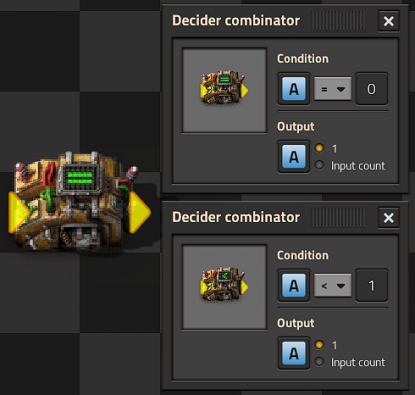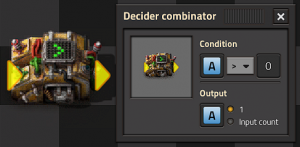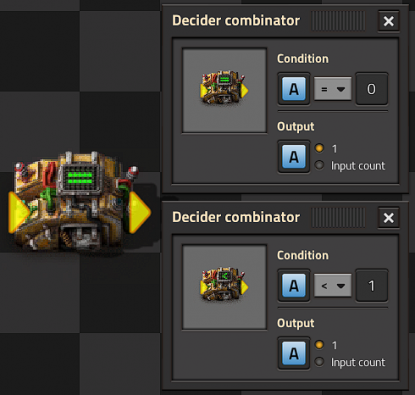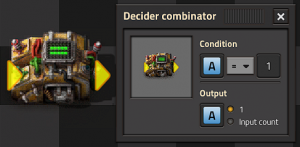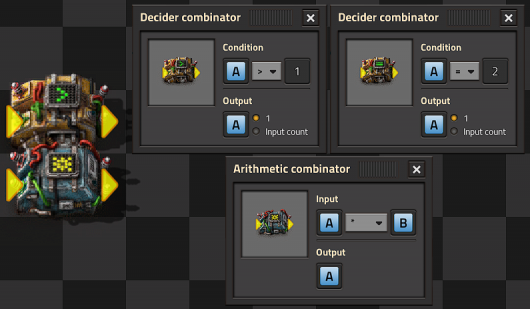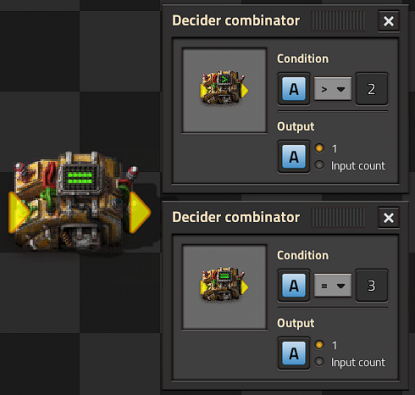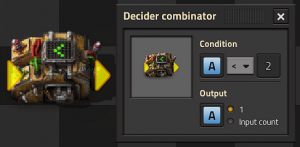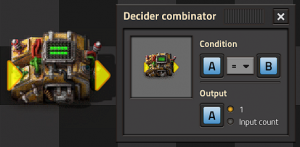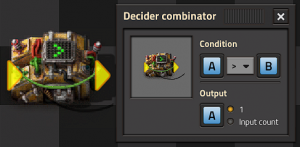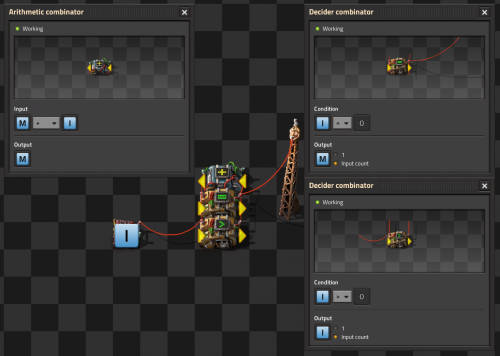Tutorial:Combinator tutorial
Introduction
Basics
Let us start with how combinator logic is processed. Combinators update at each tick, meaning if that your computer is running at 60 updates per second (UPS), your combinator similarly runs at 60 processes per second.
This is important to take into account as you build larger scale projects, as it will affect how fast your logic will run, and how much your logic will heavily task on Factorio.
Think of each signal like the number of boxes, where a wire will transport that box into other combinators that will process those boxes.
Think of a wire being that highway where boxes are transported, so boxes with the same name/label get merged as they transport those boxes, whereas boxes with different labels remain unmerged.
The first highway will not interact with another highway, so boxes with the same label do not get merged with one another when they are given separate highways - i.e. values in the green wire will not merge with values in the red wire - when those highways are connected to the same combinator, the combinator will merge those boxes.
Ability of a Combinator
Combinators can work in both positive and negative values, and is in base-10. This allows you to work with boolean/binary values (0 or 1), and integer values.
Float points do not exist in Factorio, and will be instead be bit-shifted to the nearest integer.
(9.3 becomes 9) and (10.7 becomes 10)
There is a risk for integer overflow, as combinators use signed 32-bit int, meaning the numeric range is from -2,147,483,648 to 2,147,483,647, as it can only hold 2³², or 4 billion+ values.
Basic Arithmetic
Begin with very simple maths.
Say that you wanted some production of item X to be stopped when you reached a certain amount in the logistics network.
How can we approach this problem?
The most straight-forward approach is to link the inserter that outputs the item to a passive provider chest to the logistics network when X ≥ number.
Say that instead of when X ≥ number, you instead wanted to store that item as a temporary buffer, so it produces in batches rather than being continuous.
You wanted a combinator to toggle when some value is reaches a number that sets itself, and reset itself afterwards.
This is otherwise known as a hysteresis.
The idea you have is:
When S ≤ value, send a boolean value to store, and when R ≥ value, send a boolean value to reset.
But how can we go making the mechanism that stores memory?
We can make a decider combinator that feedbacks to itself!
Given that when S > R, S can send a signal to itself saying that this condition will still hold true until R makes the condition false.
There are other approaches too, but this is the most intuitive to look at.
There is also an example heavy circuit network cookbook that you may find helpful to learn and refer to about circuit networks.
Virtual Signals
Everything Wildcard:
This Red Wildcard serves to check all the specifed input signals.
As the Decider Combinator,
its input is used to serve if all inputs meets the specified signals or variables.
its output is used to serve output every signal.
Side note: "Everything" outputs true by default even if there is no signal to guarantee if that is true. Everything is false when every input does not meet the condition, otherwise, output true.
Anything Wildcard:
This Green Wildcard serves to check all the specifed input signals.
As the Decider Combinator, its input is used to serve if any of its inputs meets the specified signals or variables.
Side note: "Anything" outputs false by default if there is no signal to guarantee if it is true. Anything is false when any of inputs do not meet the condition, otherwise, it is true.
Each Wildcard:
This Yellow Wildcard serves to check for each the specifed input signals.
As the Decider Combinator,
its input is used to serve if any inputs meets the specified signals or variables.
its output is used to serve output the each variable.
As the Arithmetic Combinator,
its input is used to serve each input, then the following summations are summed and outputted, with each signal as its own respective signals.
Input Isolator & Gate
An arithmetic combinator set to (In: Each + 0, Out: Each) can be used to swap wire colors and as an isolator to prevent downstream logic from backfeeding into the circuit network's inputs.
A decider combinator set to (Out: Everything, Input-> Output) will also function as an isolator as long as the set logic condition is true. This can also selectively pass or 'gate' inputs only when desired. This could be used to sequentially poll remote train stations for their chest contents, and include only desired stations.
Set/Reset Latching Switch
You want something to SET a trigger at some quantity, but then STAY on until that quantity hits some other value, the RESET value. You'll need one decider combinator and one arithmetic combinator. Two decider combinators and a constant combinator can also be used for more complex multi-channel conditions.
Setup the first decider combinator to the desired set conditional and to output a 1. Then connect the output to the input of an arithmetic combinator, and configure it to multiply by the bias value, the difference between the set and reset values, and wire the arithmetic output to the input of the decider. The arithmetic output channel MUST be set the same as the decider's input channel. That's it! Whenever your set conditional is reached, the decider will output a '1', and the bias of the arithmetic combinator will be applied. This will 'hold' the output true until the value goes back below the reset point.
Here's a more specific example :
i want the pump to run when petrol reach 2000, and turn off when reach 200.
only with green wire
Tank -> in decider
out decider-> in arithmetic
out arithmetic -> in decider
green wire from in decider, to pump
Pump have the same condition as the decider (Petrol > 2000)
Decider : Petrol > 2000
out : A = 1
Arithmetic : A x 1800 (2000 - 200 )
out : petrol
File:Factorio combinator switch.png
Backup steam power example with detailed configuration and explanation can be found here:
Tutorial:Circuit-network_Cookbook#SR latch - single decider version
Smart Train Loading
Initially designed by MadZuri,
This solves the problem of loading logistics into chests, which tend to be unequal and is slower in the rate of loading logistics into the cargo of trains.
To setup the design, you require an Arithmetic Combinator, as well as Red and Green wires. Wire all the chests used, to the input of the Arithmetic Combinator. Then write (Logistics Item / -Amount of chests) and as the output as the Logistics Item in the Arithmetic Combinator, this will average the amount of items within the chests. Lastly, wire all the inserters used to the output of the Arithmetic Combinator and have the other color of the wire be wired to the adjacent chest. Have the inserters enabled when Logistics Item < 1.
A more visual representation as well as questions for the design can be found here.
Explanation of why this works: It compares the average amount of total items within the chests and the chest adjacent to the inserter so that it activates when the average number of items is higher than the amount within the chest. The reason for why the division denominator is negative is because if the items in the chests are 0, it basically makes it so that it adds 1 to the equation.
Memory
How to store a constant value for later use, either for a basic counter or for more advanced logic. A decider combinator wired output tied to input and configured greater than zero (for positive values), input -> output will 'hold' a value, as long as all other inputs on the network are zero.
Any non-zero input condition will create a basic clock; incrementing the stored value by the sum of all connected input values every cycle. A single pulse of an input will cause a single increment by the pulsed value. Reset to zero occurs whenever the set condition is no longer met, or if a negative pulse equal to the input occurs.
Basic Clocks
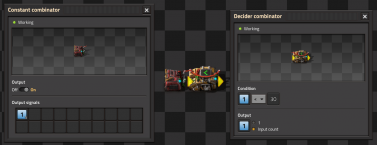
Clocks are constructed by having the output of a combinator tied back to its own input, such that every cycle advances its own count. Either the arithmetic combinator or the decider combinator can be used.
An arithmetic combinator tied to itself is fun to watch and will happily run-away, but requires additional control logic to reset.
A self-resetting clock requires just a single decider combinator with output wired to input and configured with Less Than (<) and Input -> Output. When a constant combinator is then connected to the input, every cycle it will count up by the value of the Constant Combinator until the set conditional value is reached, then output a zero which will be summed with the constant combinator, and reset the process.
The clock sequence will not include zero, will begin at the value set by the constant combinator, and will include whatever value eventually causes the conditional to be false. An arithmetic combinator can modify the clock sequence but remember its outputs will occur one cycle later than the clock cycle values.
A clock that only counts once can be built using the following setup:
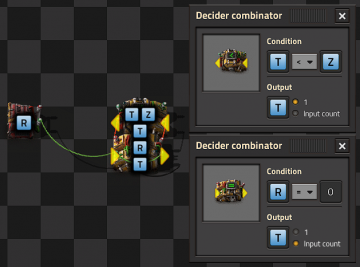
Pulse Generators
Connecting an additional (=) decider combinator to the output of a basic clock will create a pulse generator, and will pulse a single output every time the clock cycles through the set condition. Any output value can be used, either directly from the clock sequence (input->output), a 1, or some value on a separate logic channel on the circuit network, such as set by a constant combinator. or by the circuit network.
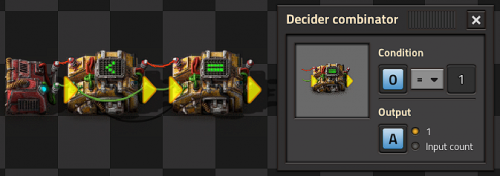
- The value 1 can be written as any positive integer, so long as it is within the cap or ceiling of your timer.
- As an example from the above timer, this light will pulse every 1st tick after the timer reaches 30 ticks, making it pulse 1/30th of a second, as Factorio updates at 60 times per second.
Counter
A counter is used to count the number of input events, and output the sum of that count. Any pulsing input into a decider combinator configured input -> output and wired between output and input will create a counter, but this input must be zero at all other times or else the combinator will run away like a clock. A pulse generator is normally used to accomplish this. Combining several gating decider isolators set with sequential conditionals, a clock, and a pulse generator to the input of a counter will allow remote polling and counting of each isolator's contents.
Logic Gates
Unary NOT
Truth Table:
| Input | Output |
|---|---|
| 0 | 1 |
| 1 | 0 |
Binary OR
Truth Table:
| Input 1 | Input 2 | Output |
|---|---|---|
| 0 | 0 | 0 |
| 0 | 1 | 1 |
| 1 | 0 | 1 |
| 1 | 1 | 1 |
*Deprecated: Use the Arithmetic Combinator's OR option instead.
Binary NOR
Truth Table:
| Input 1 | Input 2 | Output |
|---|---|---|
| 0 | 0 | 1 |
| 0 | 1 | 0 |
| 1 | 0 | 0 |
| 1 | 1 | 0 |
Binary XOR
Truth Table:
| Input 1 | Input 1 | Output |
|---|---|---|
| 0 | 0 | 0 |
| 0 | 1 | 1 |
| 1 | 0 | 1 |
| 1 | 1 | 0 |
*Deprecated: Use the Arithmetic Combinator's XOR option instead.
Binary AND
Truth Table:
| Input 1 | Input 2 | Output |
|---|---|---|
| 0 | 0 | 0 |
| 0 | 1 | 0 |
| 1 | 0 | 0 |
| 1 | 1 | 1 |
*Deprecated: Use the Arithmetic Combinator's AND option instead.
Trinary AND
Truth Table:
| Input 1 | Input 2 | Input 3 | Output |
|---|---|---|---|
| 0 | 0 | 0 | 0 |
| 0 | 1 | 0 | 0 |
| 0 | 0 | 1 | 0 |
| 0 | 1 | 1 | 0 |
| 1 | 0 | 0 | 0 |
| 1 | 1 | 0 | 0 |
| 1 | 0 | 1 | 0 |
| 1 | 1 | 1 | 1 |
Binary NAND
Truth Table:
| Input 1 | Input 2 | Output |
|---|---|---|
| 0 | 0 | 1 |
| 0 | 1 | 1 |
| 1 | 0 | 1 |
| 1 | 1 | 0 |
Binary XNOR/XAND
Truth Table:
| Input 1 | Input 2 | Output |
|---|---|---|
| 0 | 0 | 1 |
| 0 | 1 | 0 |
| 1 | 0 | 0 |
| 1 | 1 | 1 |
Memory Cells
Simple Latch
When looping the combinator to itself, use a different colour of wire from your main inputs or outputs.
Truth Table:
| Output 1 | Input 1 | Input 2 | Output 1 (t+1) |
|---|---|---|---|
| 0 | 0 | 0 | 0 |
| 0 | 1 | 0 | 1 |
| 0 | 0 | 1 | 0 |
| 0 | 1 | 1 | 0 |
| 1 | 0 | 0 | 1 |
| 1 | 1 | 0 | 1 (2) |
| 1 | 0 | 1 | 0 |
| 1 | 1 | 1 | 1 (2) |
Output 1 is the green wire loop seen in the picture, it carries the value to latch.
Input 1 is Set, while Input 2 is Reset.
Binary Cell
RS NOR Latch File:RS-NOR.png
Advanced Cell
Cell for storing a positive value:
Connect the desired value as signal 3 on the right side to set the memory cell and connect a negative value as signal 3 to reset the cell. *Please note the arithmetic combinator's output should be facing the opposite direction of the decider combinators.
Address Enable Switch
